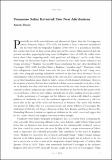Files in this item
Tommaso Salini revisited: two new attributions
Item metadata
| dc.contributor.author | Thom, Aaron James | |
| dc.date.accessioned | 2015-08-28T13:55:54Z | |
| dc.date.available | 2015-08-28T13:55:54Z | |
| dc.date.issued | 2014-07-08 | |
| dc.identifier.citation | Thom, A. (2014). Tommaso Salini revisited: two new attributions. North Street Review: Arts and Visual Culture, 17, pp. 7-19. | en_US |
| dc.identifier.issn | 2053-2024 | en_US |
| dc.identifier.uri | http://ojs.st-andrews.ac.uk/index.php/nsr/article/view/719 | en_US |
| dc.identifier.uri | https://hdl.handle.net/10023/7347 | |
| dc.description.abstract | Tommaso Salini (c.1575–1625) is a frequently forgotten Baroque artist that fell under Caravaggio’s spell, despite having a tempestuous relationship with the great painter. Salini, also known as Mao, was a friend of Giovanni Baglione, the Italian art biographer, who included Salini in his Le vite de’ pittori (1642). Salini is better remembered for his role in the Baglione libel trial of 1603 than he is for his oil paintings, which sit between Caravaggio’s innovative way of painting and Baglione’s mediocre Mannerism. Art historians have often shied away from exploring Salini’s career because the canvases that have carried his name seem stylistically dissimilar. The recent tendency has been to attribute these works to the anonymous ‘Pseudo-Salini’ painters, but this should form the topic of a separate article. The twentieth century saw art historians generously attribute an excessive amount of work to Salini, and many of these pictures were probably done decades after his death. In order for Salini’s oeuvre to be presented with accuracy, connoisseurs have had to inspect the original works that Baglione mentions being by Salini’s hand, as well as the pictures that have been successfully attributed to him. Bearing in mind what Baglione wrote, Salini can be revealed as an innovate artist and still life specialist. This article includes a newly attributed still life (Museum of Fine Arts, Boston) as a forgotten Salini, as well as a refreshed attribution of the masterful Piping Shepherd Boy (Foundling Museum, London). These works add weight to Salini being a more famous and better-known painter in his own time than scholarship has shown. | en_US |
| dc.language.iso | en | en_US |
| dc.publisher | School of Art History, University of St Andrews | en_US |
| dc.relation.ispartof | North Street Review: Arts and Visual Culture | en_US |
| dc.rights | Copyright (c) The author(s). This is an open access article published in North Street Review. This work is licensed under a Creative Commons Attribution-NonCommercial 4.0 Licence (http://creativecommons.org/licenses/by-nc/4.0//) | en_US |
| dc.rights.uri | http://creativecommons.org/licenses/by-nc/4.0// | |
| dc.subject | Connoisseurship | en_US |
| dc.subject | Caravaggism | en_US |
| dc.subject | Attribution | en_US |
| dc.subject.lcsh | Art--History | en_US |
| dc.title | Tommaso Salini revisited: two new attributions | en_US |
| dc.type | Journal article | en_US |
| dc.description.version | https://doi.org/Publisher PDF | en_US |
| dc.publicationstatus | Published | en_US |
| dc.status | Peer reviewed | en_US |
This item appears in the following Collection(s)
Except where otherwise noted within the work, this item's licence for re-use is described as Copyright (c) The author(s). This is an open access article published in North Street Review. This work is licensed under a Creative Commons Attribution-NonCommercial 4.0 Licence (http://creativecommons.org/licenses/by-nc/4.0//)
Items in the St Andrews Research Repository are protected by copyright, with all rights reserved, unless otherwise indicated.


